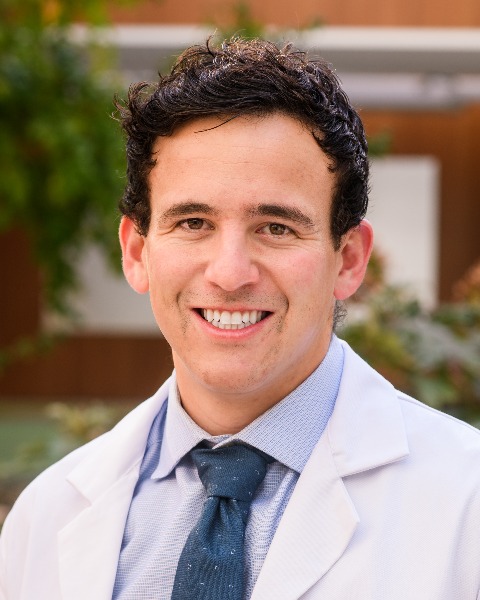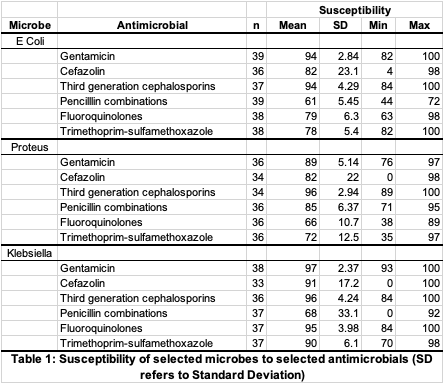Back
Poster, Podium & Video Sessions
Podium
PD21: Infections/Inflammation/Cystic Disease of the Genitourinary Tract: Kidney & Bladder II
PD21-11: Within State Variability of Antimicrobial Susceptibility: Missouri as an Archetype to Assess Guidelines for Antimicrobial Prophylaxis for Transurethral Procedures
Saturday, May 14, 2022
8:40 AM – 8:50 AM
Location: Room 243
Corbin Wright, Geoffrey Rosen*, Shubham Kanake, Mojgan Golzy, Katie Murray, Columbia, MO

Geoffrey H. Rosen, MD
University of Missouri
Podium Presenter(s)
Introduction: The American Urological Association has developed recommendations for antimicrobial prophylaxis for transurethral (TU) procedures. Specific regimens are advised, with the guidance for urologists to check their local antibiograms. Here, we use Missouri to examine the presence and variability in antibiograms within a state, helping to show the ease with which a urologist may consider a local antibiogram.
Methods: All hospitals in the state of Missouri were identified using the American Hospital Directory and contacted to request antibiograms. Hospital characteristics including bed-size, location, and rurality were collected. Based on results of our prior antibiogram work, we studied E. coli, Klebsiella, and Proteus. We evaluated susceptibility to trimethoprim-sulfamethoxazole (TMP-SMX), Third generation cephalosporins, cefazolin, penicillin combinations, gentamicin and fluoroquinolones. We looked at overall variability and looked for association with hospital bed-size, location, and rurality
Results: Eighty-two hospitals were contacted, and data is included from thirty-nine (48% response rate). Susceptibility of relevant microbes to frequently used antimicrobials is displayed in Table 1. The only statistically significant correlation between hospital characteristics and susceptibility was between increased hospital bed-size and E. coli resistance to penicillin combinations (P=0.001; R-squared=0.47).
Conclusions: Prior work has shown low susceptibility of common infectious agents after TU procedures to first-line recommended prophylactic antimicrobials. Here, we apply similar methods to a study of hospitals in Missouri. First-line recommendations have low coverage, 82% mean susceptibility for E. coli for 1st generation cephalosporins and 78% for TMP-SMX. Third generation cephalosporins showed high susceptibilities, as did gentamicin. Current recommendations for TU prophylaxis advise use of local antibiograms, yet we were unable to acquire antibiograms from more than half of contacted hospitals. Urologists should consider local patterns when selecting antimicrobials for TU procedure prophylaxis. If not possible, broader-spectrum antimicrobials than current recommendations may be useful.
Source of Funding: NA

Methods: All hospitals in the state of Missouri were identified using the American Hospital Directory and contacted to request antibiograms. Hospital characteristics including bed-size, location, and rurality were collected. Based on results of our prior antibiogram work, we studied E. coli, Klebsiella, and Proteus. We evaluated susceptibility to trimethoprim-sulfamethoxazole (TMP-SMX), Third generation cephalosporins, cefazolin, penicillin combinations, gentamicin and fluoroquinolones. We looked at overall variability and looked for association with hospital bed-size, location, and rurality
Results: Eighty-two hospitals were contacted, and data is included from thirty-nine (48% response rate). Susceptibility of relevant microbes to frequently used antimicrobials is displayed in Table 1. The only statistically significant correlation between hospital characteristics and susceptibility was between increased hospital bed-size and E. coli resistance to penicillin combinations (P=0.001; R-squared=0.47).
Conclusions: Prior work has shown low susceptibility of common infectious agents after TU procedures to first-line recommended prophylactic antimicrobials. Here, we apply similar methods to a study of hospitals in Missouri. First-line recommendations have low coverage, 82% mean susceptibility for E. coli for 1st generation cephalosporins and 78% for TMP-SMX. Third generation cephalosporins showed high susceptibilities, as did gentamicin. Current recommendations for TU prophylaxis advise use of local antibiograms, yet we were unable to acquire antibiograms from more than half of contacted hospitals. Urologists should consider local patterns when selecting antimicrobials for TU procedure prophylaxis. If not possible, broader-spectrum antimicrobials than current recommendations may be useful.
Source of Funding: NA


.jpg)
.jpg)